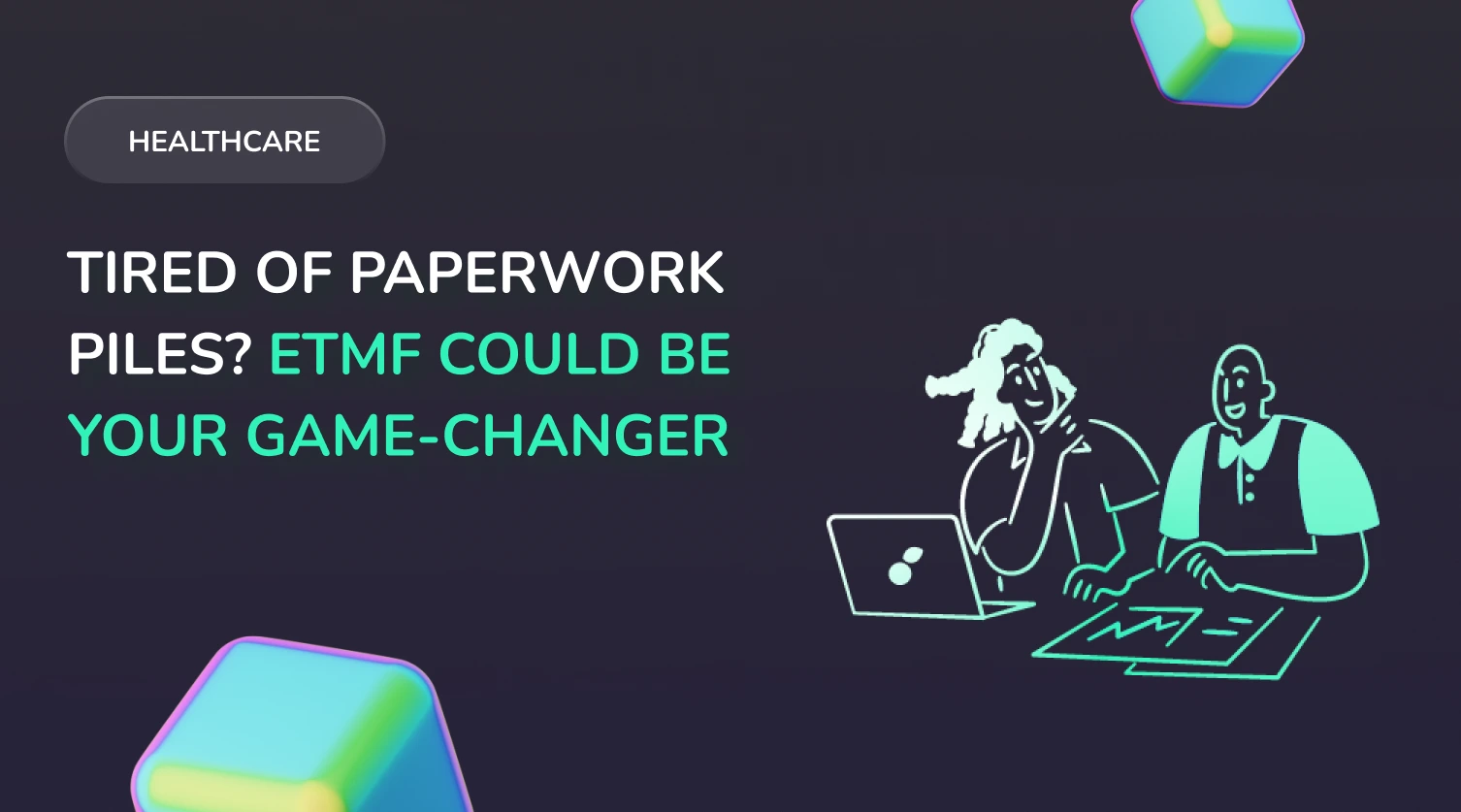
Clinical trials are a complex, multi-layered process that directly impacts patient safety and the effectiveness of new drugs. At the heart of every trial lies documentation. Without it, nothing moves forward.
However, since physical documents can easily get lost, you need to create a digital system where all data will be safe. But how to do it properly? With automation and strict adherence to eTMF guidelines, managing and auditing clinical trial documents becomes much easier. Interested in how these tools can help you?
What is an eTMF software?
A Trial Master File (TMF) is the central collection of documents reflecting a clinical trial’s conduct and quality. Its primary purpose is to serve as documented evidence that the trial was conducted in line with:
- Good Clinical Practice (GCP),
- Local and international regulatory standards (e.g., FDA, EMA),
- The approved study protocol.
It’s typically used by sponsors, CROs (Contract Research Organizations), clinical project managers, and QA professionals to ensure the traceability of clinical decisions and actions taken during a study.
Just a few years ago, most TMFs were a collection of paper folders or fragmented electronic files spread across network drives and Excel sheets. It led to poor document tracking, data gaps, and loss.

Medicine is not the cheapest field. So, don’t make it even more expensive with old-style paper resolutions. Make it more effort-friendly with digital solutions.
However, everything changes, and now more and more businesses are interested in the implementation of the eTMF system, where all data will be stored and examined in one place. These platforms enable real-time tracking of TMF completeness and regulatory compliance while simplifying audit and inspection readiness by supporting version control, electronic signatures, and audit trails by default.
Core Functions and Capabilities of eTMF Systems
Unlike traditional paper files or scattered hybrid solutions, an electronic Trial Master File (eTMF) is a centralized system that goes far beyond simple storage. They streamline collaboration across stakeholders, reduce manual errors, and accelerate readiness for audits and inspections. Let’s examine the 9 core features of eTMF solutions below.
1. Centralized Document Storage
eTMF systems provide a single, secure cloud-based repository to manage clinical files, eliminating the need for scattered storage across email inboxes, local folders, shared network drives, or outdated spreadsheets.
Centralization ensures that every stakeholder, from sponsors and CROs to site staff and auditors, can remotely access the most up-to-date documents in real time. It reduces the risk of version mismatches, lost files, or outdated templates being used.
Meanwhile, you don’t need to worry about safety, since those platforms have role-based access, so each user sees only what’s relevant to their responsibilities. The centralized environment also supports business continuity, making sure documents are protected against local hardware failures or human error.
2. Standardized Structure (DIA Reference Model)
eTMF systems use common frameworks like the DIA TMF Reference Model to structure documentation. This standardization makes it easy to find what you need. Forget about digging through messy folders, as everything will be properly sorten. Since the eTMF structure is inspection-ready by design, it accelerates preparation for audits and inspections and increases inspector confidence in your processes.
3. Version Control and Change Logs
With eTMF, you never have to wonder who changed what or when. Every edit, upload, or update is automatically logged, including the user, timestamp, and exact modifications. No more chasing down the “latest version” or digging through old emails to figure out what happened.
This level of traceability is a core requirement for compliance with GCP and regulations like FDA 21 CFR Part 11. And when audit day comes? You’ve got a clean, transparent record ready to go.
4. Real-Time Completeness Tracking
eTMF in clinical research gives you a clear, up-to-the-minute view of your documentation status. You can instantly see which sections are complete, which ones still need documents, and what’s overdue. This visual tracking helps teams stay proactive, so missing files don’t sneak up on you at the worst possible moment.
5. Role-Based Access Control
Only the right eyes see the right stuff. That’s the idea behind role-based access. It cuts noise while protecting sensitive files. No clutter, no leaks, no headaches.
6. Electronic Signature Support
Approvals shouldn’t be a bottleneck. eTMF systems support fully compliant electronic signatures — aligned with 21 CFR Part 11 and EU guidelines — so documents can be signed, sealed, and approved without printing or scanning.
It’s fast, secure, and audit-ready by design. Teams can keep momentum without compromising on regulatory standards — and you can say goodbye to chasing paper trails.
7. Full Audit Trail
Every click and action counts. eTMF solutions ensure that make sure it’s all recorded. Whether someone uploads a file, edits a document, views sensitive data, or deletes a draft, it’s logged in real time.
That way, is system creates a transparent, tamper-proof timeline that’s invaluable for both internal quality checks and regulatory inspections. No more digging through emails or folders to figure out what happened when.
8. Integration with Other Systems
A strong eTMF doesn’t work as a silo. You should develop or use the ready-made platform that connects easily with your CTMS, EDC, IRT, and other tools, creating one cohesive digital workspace. It helps you to lower the number of manual updates, reduce errors, and provide a lot more visibility across the entire study lifecycle.
9. Inspection & Audit Readiness
Electronic trial master file software can generate reports and provide tailored access to all necessary files, drastically reducing the time and effort required to prepare for regulatory inspections or sponsor audits. Remember that preparing for an audit shouldn’t feel like panic mode. With an eTMF, you can generate custom reports and grant real-time access to just the right documents.
Why eTMF Matters in Modern Clinical Trials
Modern eTFMs transform the messy chaos of clinical trial documentation into a streamlined and compliant process. It’s about running smarter, faster, and inspection-ready trials from day one, providing you with the following benefits:
- Faster document handling and less admin overhead
- Fewer mistakes and duplicate files
- Greater transparency across all stakeholders
- Always inspection-ready
- Better risk management
1. Faster Document Handling and Less Admin Overhead
With eTMF tools, you spend way less time hunting down files in folders or spreadsheets since everything is organized, searchable, and just a few clicks away. Instead of digging through emails or trying to find the latest Excel version, teams can:
- Instantly locate documents using filters, keywords, or categories
- Check real-time status (e.g., draft, under review, signed, approved)
- View version history, comments, and who’s responsible for what
- See deadlines and ownership clearly
Teams get hours (sometimes weeks) back, especially in large, multi-site trials.
2. Fewer Mistakes and Duplicate Files
Manual processes can lead to mistakes, lost files, or wrong versions due to human error.
With eTMF, most of that goes away:
- Templates and validation rules ensure docs are uploaded correctly
- Version control means no more “Wait, is this the latest one?”
- Real-time alerts flag duplicates, outdated files, or missing approvals
The eTMF SaaS system acts like a second set of eyes, catching issues before they become compliance risks. That’s peace of mind you can’t get from folders and sticky notes.
3. Greater Transparency Across All Stakeholders
Everyone in the medical process should be on the same page, and such services help them make it. eTMF ensures that everyone works in one digital space, accessing the up-to-date files. Role-based access keeps data secure but available to the right people at the right time. Meanwhile, automatic audit trails log every action.
This level of transparency builds trust, speeds up communication, and helps teams move in sync, even when they’re continents apart.
4. Always Inspection-Ready
Inspections can happen anytime, and when they do, panic is not a strategy. With eTMF, your team is always ready for inspections since all documents are placed together, structured to meet GCP and regulatory standards. Meanwhile, you can examine overall TMF health, approval stages, and deadline breaches through user-friendly dashboards.
5. Better Risk Management
One tiny doc issue can cause a huge regulatory delay. Or worse, it can fully invalidate your data. The scary part? These issues often go unnoticed until it’s too late. However, the eTMF clinical trial software brings you full control of your data with real-time alerts that highlight missing or overdue documents.
Integration with systems like CTMS or eISF can give you a 360° view, while automated workflows can cut down the possibility of human error. So, with such systems, you take risk management into your hands, keeping the situation under control.
Real-World Example: How Pfizer Uses eTMF for Global Trial
Pfizer collaborated with Wingspan to create a comprehensive eTMF clinical trials system to transform their record management. The collaboration involved a meticulous 2-year-long development that ended up creating a full-scale electronic TMF system for managing all their medical studies. It improves their efficiency, simplifying the process of creating new medicines.
The Future of eTMF and the Digital Transformation of Clinical Research
The future of digital trial systems is bright. Just a few years ago, eTMF meant a hidden repository sense, but now it’s a large system with a myriad of features and integrations. Now you can modify data, share it, and keep using this system as a dynamic, ever-changing hub. So, let’s examine what eTMF features will become the new norm in the next 3-5 years.
Integration with Other Digital Platforms
Modern eDTF has gradually become a hub for all clinical data, including various data from different stakeholders, such as essential patient data from clinics, reports from investigators and coordinators, data verification from biostatisticians, etc. Meanwhile, API integrations allow sponsors and regulatory bodies to better examine your trial data with their tools.
eTMF systems are designed to integrate with:
- CTMS (Clinical Trial Management Systems): Aligning operational workflows and tracking study milestones.
- eISF (Electronic Investigator Site Files): Synchronizing documents at the site level.
- EDC (Electronic Data Capture): Merging operational documentation with real-time clinical data.
The Growing Role of Artificial Intelligence
AI tools become a driving force of innovations, and eTMF SaaS isn’t the exception. Technologies like Optical Character Recognition (OCR) streamline the ingestion and classification of files. Documents are now “read” by the system, tagged appropriately, and placed in the right spot in the TMF structure — all without human intervention.
AI-based validation models can proactively flag missing documents, detect inconsistencies, or highlight compliance gaps. That way, you can prevent risks, without the nerves of outdoing them.
Decentralized Trials: The Future is the Now
Decentralized clinical trials (DCTs) will continue to reshape the conduct of clinical studies. Modern eTMF in clinical research allows patients to use intuitively clear apps and wearables to provide their data in real-time.
By integrating tools like electronic consent (eConsent) and remote case report form (CRF) entry, the eTMF helps you to keep everything in place while ensuring full compliance.
Wrapping Up
Medical trials are too important and too expensive to be managed with scattered folders. An eTMF planning can help you pass the chaos and make your clinical trial process as smooth as possible. These systems connect teams, support compliance, and put every piece of your trial in place.
The eTMF selection is a crucial part of modern medicine. eTMF adoption in 2025 isn’t just a tech upgrade, but more like a strategic move toward faster trials, cleaner audits, and confident regulatory submission.
Subscribe to our blog


